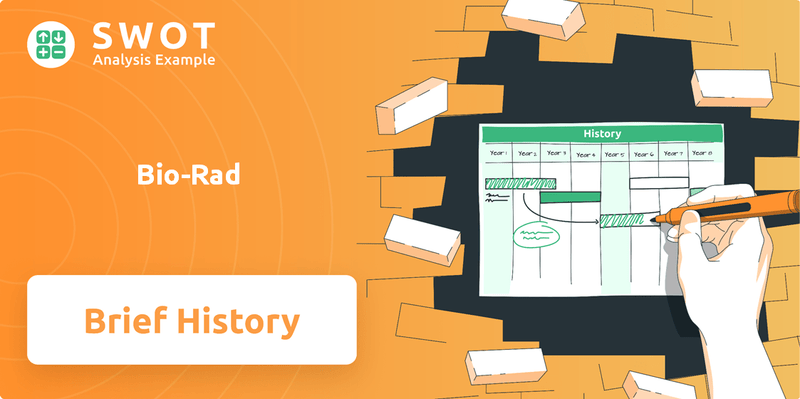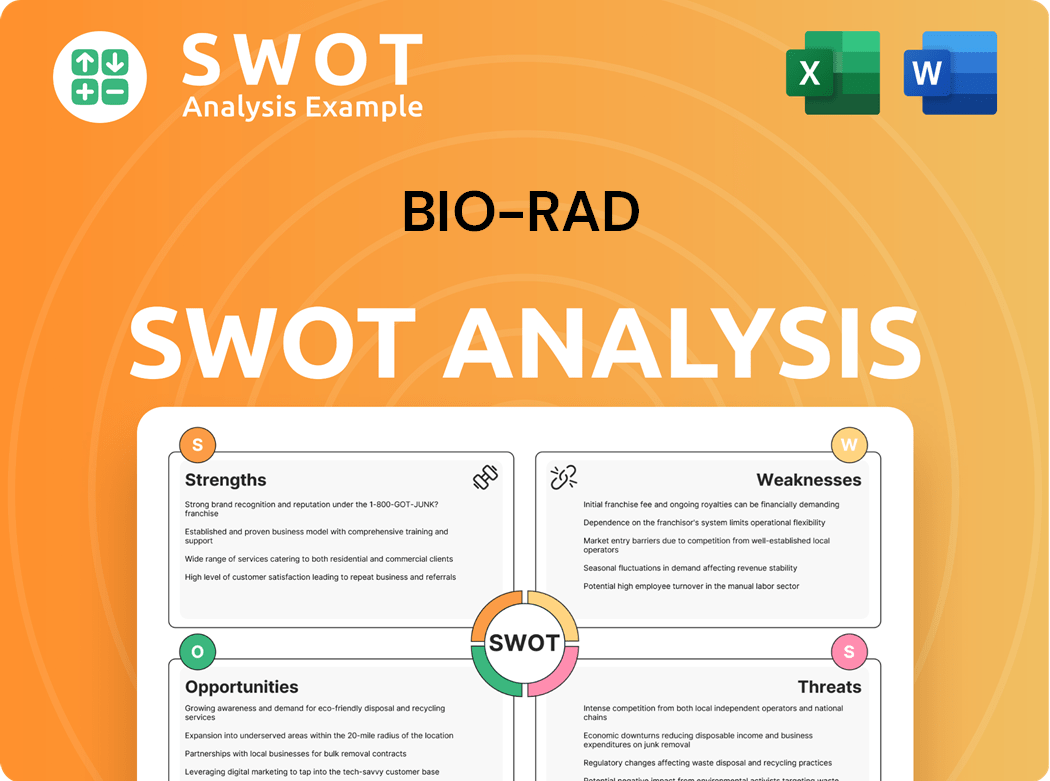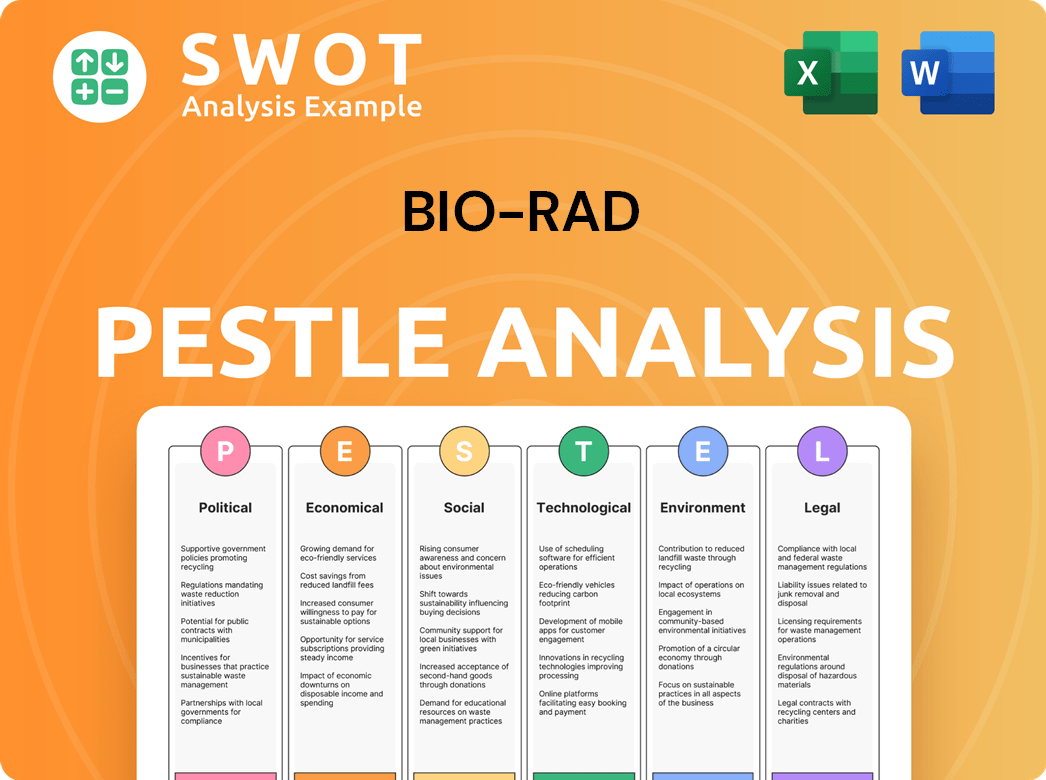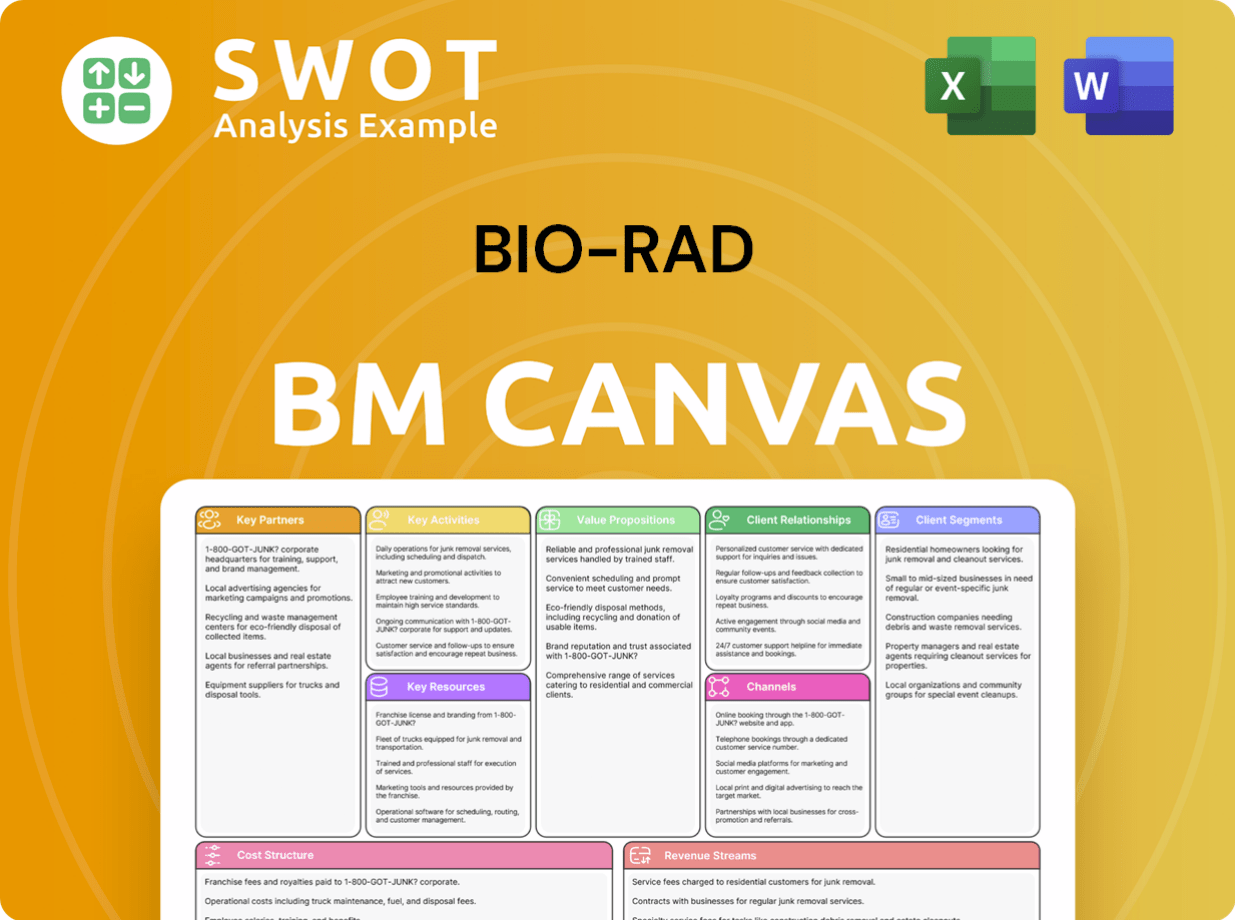Bio-Rad Bundle
How Did Bio-Rad Become a Global Leader?
Embark on a journey through time to uncover the fascinating Bio-Rad SWOT Analysis and the remarkable story of Bio-Rad Laboratories. From its humble beginnings in 1952, this pioneering company has reshaped the landscape of life science and clinical diagnostics. Discover how a vision of accelerating scientific progress fueled Bio-Rad's evolution into a global powerhouse.

The Bio-Rad company story is one of continuous innovation and strategic growth, reflecting the dynamic nature of the life science and biotechnology sectors. Understanding the Bio-Rad history, from its early focus on specialty chemicals to its current diverse portfolio of Bio-Rad products and services, offers valuable insights for investors and industry observers alike. Explore the key milestones, Bio-Rad acquisitions, and Bio-Rad innovations that have shaped the company's enduring legacy and global presence.
What is the Bio-Rad Founding Story?
The story of Bio-Rad begins in 1952 with David and Alice Schwartz, a husband-and-wife team from the University of California, Berkeley. They started the company with a clear mission: to speed up scientific breakthroughs by providing researchers with ready-to-use tools and products. This marked the inception of what would become a major player in the life science and biotechnology industries.
Their initial base of operations was a Quonset hut in West Berkeley, California. This humble beginning reflects the early, resource-conscious approach of the founders. The Schwartz's identified a significant need in the scientific community, particularly the time-consuming process of preparing biochemicals. They aimed to solve this by offering pre-made solutions, allowing scientists to focus on their research.
The company's name, 'Bio-Rad,' is a combination of 'Biochemical-Radiochemical Laboratories,' which reflects its early focus. David Schwartz led the company as President, CEO, and Chairman from 1957 to 2003, demonstrating a long-term commitment. The company's launch in the post-World War II era, with growing scientific research, set the stage for its future growth.
Bio-Rad Laboratories was founded in 1952 by David and Alice Schwartz, graduates of the University of California, Berkeley.
- The company started in a Quonset hut in West Berkeley, California.
- Bio-Rad's initial goal was to accelerate scientific discovery by providing ready-to-use products.
- Their first product was tobacco mosaic virus (TMV).
- The name 'Bio-Rad' comes from 'Biochemical-Radiochemical Laboratories.'
Bio-Rad SWOT Analysis
- Complete SWOT Breakdown
- Fully Customizable
- Editable in Excel & Word
- Professional Formatting
- Investor-Ready Format

What Drove the Early Growth of Bio-Rad?
The early years of Bio-Rad Laboratories were marked by rapid expansion and diversification. The company, which began with a focus on laboratory research, quickly broadened its scope. This period saw significant developments in product offerings and geographical reach, establishing the foundation for its future growth.
In the 1950s, Bio-Rad introduced its initial analytical grade ion exchange resins, marking the launch of its Life Science Group. This move expanded the company's portfolio beyond its original offerings. This expansion was a key step in establishing Bio-Rad as a significant player in the scientific community.
The year 1957 was pivotal as Bio-Rad was officially incorporated. In 1958, the company relocated its headquarters to Richmond, California. These actions provided a more stable base for the company's operations and future growth.
A major milestone was reached in 1966 when Bio-Rad went public, offering its stock to the public. Simultaneously, the company began its international expansion, opening its first overseas office in Germany. These strategic steps broadened its financial base and global reach.
Leveraging its expertise in ion exchange resins, Bio-Rad entered the clinical diagnostics field in the 1960s. The introduction of the T-4 thyroid test in 1967 was a breakthrough. By the early 1970s, the company had diversified into tests for various medical conditions.
In 1976, Bio-Rad acquired Environmental Chemical Specialties (ECS), strengthening its position in clinical diagnostics. Under the leadership of David Schwartz, the company consistently expanded its product lines and geographical markets. This strategy laid the groundwork for its global network.
The strategic expansion and diversification during these early decades were crucial. Today, Bio-Rad has a dual focus on Life Science research and clinical diagnostics. The company's early moves set the stage for its continued success and impact on the biotechnology sector. For more details on the company's history, you can explore a comprehensive Bio-Rad history overview.
Bio-Rad PESTLE Analysis
- Covers All 6 PESTLE Categories
- No Research Needed – Save Hours of Work
- Built by Experts, Trusted by Consultants
- Instant Download, Ready to Use
- 100% Editable, Fully Customizable

What are the key Milestones in Bio-Rad history?
The Bio-Rad history is marked by significant milestones in the biotechnology and life science industries. The company has consistently adapted to industry changes, driving innovation and expanding its global presence.
| Year | Milestone |
|---|---|
| 2011 | Acquired droplet digital PCR (ddPCR) technology, a groundbreaking innovation. |
| 2024 | Invested in Geneoscopy and partnered with Oncocyte, expanding the ddPCR platform. |
| 2024 | Achieved IVDR Class C certification for the QXDx BCR-ABL %IS Kit. |
Bio-Rad Laboratories has consistently focused on innovation, particularly in the field of droplet digital PCR (ddPCR). In 2024, the company continued to launch new products, including kits for gene therapy production and single-cell transcriptomic research, demonstrating its commitment to advancing biotechnology.
The acquisition of ddPCR technology in 2011 was a pivotal moment, becoming a cornerstone of Bio-Rad's offerings. This technology has enabled more precise and sensitive analysis in various applications, including oncology and infectious disease diagnostics.
In 2024, Bio-Rad launched several new products, including the Vericheck ddPCR Replication Competent Lentivirus Kit and Replication Competent AAV Kit for gene therapy production. These additions highlight the company's focus on supporting cutting-edge research and development.
The introduction of the ddSEQ Single-Cell 3′ RNA-Seq Kit with Omnition v1.1 software in 2024 demonstrates Bio-Rad's commitment to single-cell transcriptomic research. This technology allows researchers to gain deeper insights into cellular processes.
The ddPLEX ESR1 Mutation Detection Kit, also launched in 2024, further supports oncology research and diagnostics. This kit helps in the detection of specific mutations, aiding in the development of targeted therapies.
The IVDR Class C certification for the QXDx BCR-ABL %IS Kit in 2024 highlights Bio-Rad's leadership in oncology diagnostics. This certification ensures the quality and reliability of the kit for monitoring chronic myeloid leukemia patients.
Bio-Rad partnered with companies like Geneoscopy and Oncocyte to expand its ddPCR platform. These partnerships support the commercialization of innovative diagnostic tests and expand the reach of Bio-Rad's technologies.
Despite its achievements, Bio-Rad has faced challenges, including headwinds in the biopharma market and intense competition. The company has responded to these challenges through ongoing transformation initiatives and cost management.
In 2024, Bio-Rad experienced headwinds in the biopharma market, which impacted the Life Science segment results. The slower-than-expected market recovery posed challenges for the company's financial performance.
Bio-Rad faces intense competition from major players like Thermo Fisher Scientific, Agilent Technologies, and Illumina. This competitive landscape requires continuous innovation and strategic adaptation.
The company also navigates regulatory hurdles and pricing pressures, which can impact profitability. These factors require Bio-Rad to maintain operational efficiency and strategic pricing strategies.
Bio-Rad has responded to these challenges through ongoing transformation initiatives and diligent cost management. These efforts aim to improve operational efficiency and enhance financial performance.
Cost management strategies, such as consolidating European manufacturing sites into the Singapore hub, helped expand gross margins in 2024. These strategies contribute to improved financial results.
Bio-Rad's resilience and adaptability, coupled with its commitment to quality and innovation, have been key to its sustained success. The company continues to navigate challenges and maintain its leadership in the biotechnology industry.
Bio-Rad Business Model Canvas
- Complete 9-Block Business Model Canvas
- Effortlessly Communicate Your Business Strategy
- Investor-Ready BMC Format
- 100% Editable and Customizable
- Clear and Structured Layout

What is the Timeline of Key Events for Bio-Rad?
The Bio-Rad history began in 1952, founded by David and Alice Schwartz in Berkeley, California. Initially focused on laboratory research, the company expanded significantly over the years, becoming a public entity in 1966 and establishing an international presence. Key milestones include the introduction of groundbreaking products and strategic acquisitions, such as the acquisition of droplet digital PCR (ddPCR) technology in 2011, which has been a cornerstone of their innovation. The company's journey showcases a commitment to scientific advancement and healthcare improvement through its innovative products and services.
| Year | Key Event |
|---|---|
| 1952 | Founded by David and Alice Schwartz in Berkeley, California, marking the start of the |
| 1957 | Incorporated, solidifying its structure. |
| 1966 | Became a public company and expanded internationally with its first overseas office in Germany. |
| 1967 | Introduced the T-4 (thyroxine) thyroid test, a pioneering commercial test. |
| 2003 | Norman Schwartz, son of the founders, assumed the role of President and Chief Executive Officer. |
| 2011 | Acquired droplet digital PCR (ddPCR) technology, a significant advancement. |
| 2024 | Reported revenues of $2.6 billion, with a focus on advancing its transformation. |
| 2025 (February) | Announced intent to acquire Stilla Technologies, a digital PCR developer. |
| 2025 (May) | Reported Q1 2025 total net sales of $585.4 million. |
In 2024,
The acquisition of Stilla Technologies, expected to close by the end of Q3 2025, highlights
For the full year 2025,
Strategic initiatives include further expanding the Droplet Digital PCR platform into life science research and clinical diagnostics. Continued share repurchases and strategic investments are planned. The company aims to advance scientific discovery and improve healthcare through innovative, high-quality products, staying true to its original mission.
Bio-Rad Porter's Five Forces Analysis
- Covers All 5 Competitive Forces in Detail
- Structured for Consultants, Students, and Founders
- 100% Editable in Microsoft Word & Excel
- Instant Digital Download – Use Immediately
- Compatible with Mac & PC – Fully Unlocked

Related Blogs
- What is Competitive Landscape of Bio-Rad Company?
- What is Growth Strategy and Future Prospects of Bio-Rad Company?
- How Does Bio-Rad Company Work?
- What is Sales and Marketing Strategy of Bio-Rad Company?
- What is Brief History of Bio-Rad Company?
- Who Owns Bio-Rad Company?
- What is Customer Demographics and Target Market of Bio-Rad Company?
Disclaimer
All information, articles, and product details provided on this website are for general informational and educational purposes only. We do not claim any ownership over, nor do we intend to infringe upon, any trademarks, copyrights, logos, brand names, or other intellectual property mentioned or depicted on this site. Such intellectual property remains the property of its respective owners, and any references here are made solely for identification or informational purposes, without implying any affiliation, endorsement, or partnership.
We make no representations or warranties, express or implied, regarding the accuracy, completeness, or suitability of any content or products presented. Nothing on this website should be construed as legal, tax, investment, financial, medical, or other professional advice. In addition, no part of this site—including articles or product references—constitutes a solicitation, recommendation, endorsement, advertisement, or offer to buy or sell any securities, franchises, or other financial instruments, particularly in jurisdictions where such activity would be unlawful.
All content is of a general nature and may not address the specific circumstances of any individual or entity. It is not a substitute for professional advice or services. Any actions you take based on the information provided here are strictly at your own risk. You accept full responsibility for any decisions or outcomes arising from your use of this website and agree to release us from any liability in connection with your use of, or reliance upon, the content or products found herein.